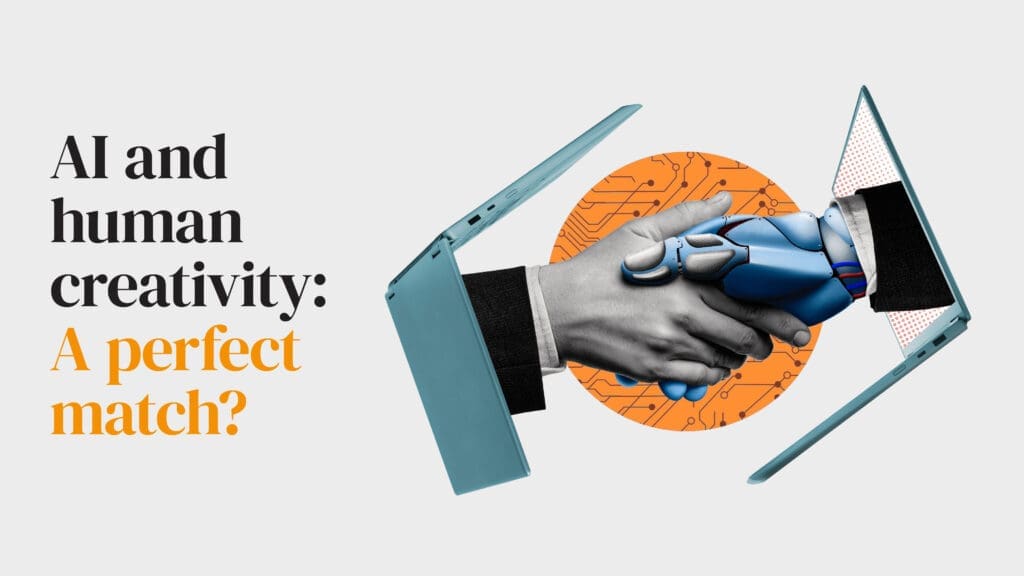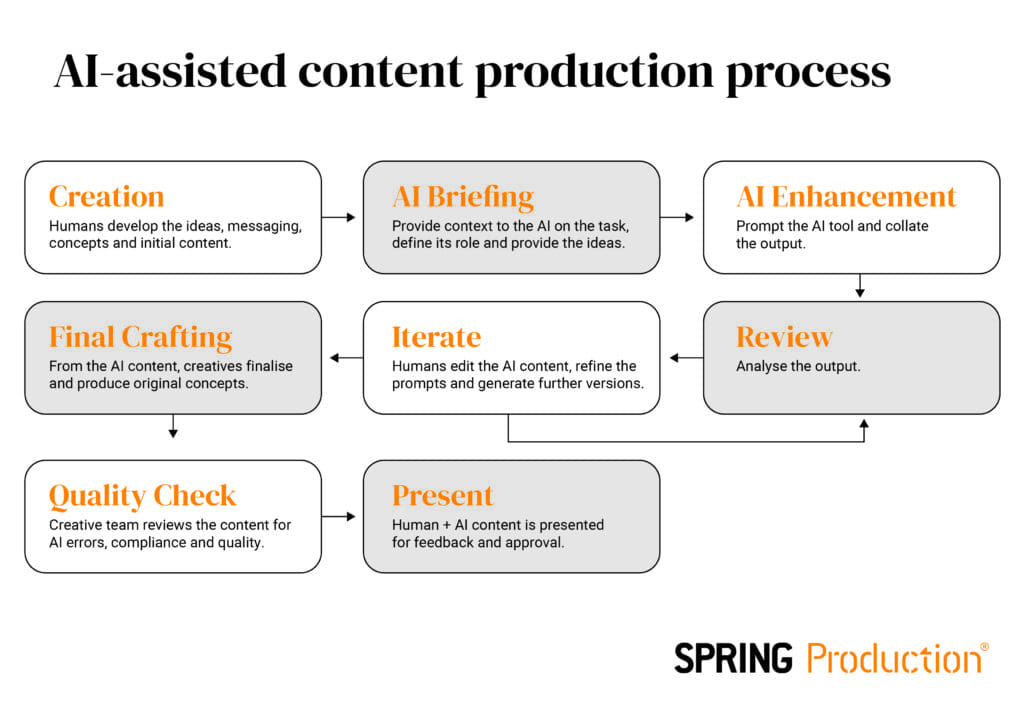Let’s face it. AI isn’t going anywhere. Tools like Dall-e, Midjourney, ChatGPT, and Sora have disrupted the creative industry and revolutionised the way we all work. They’ve given brands new ways to optimise content creation, ramp up productivity, and slash costs. Hell, they’ve even threatened to replace human creatives all together! But as the dust settles, humans, you’ll be glad to know, remain crucial to the creative process. Why? Because the full potential of AI can only be harnessed when integrated into the creative process by human hands. But this raises more questions than answers: How should humans and AI best collaborate? What roles are best suited to AI? And how can marketing teams maintain the benefits of AI without sacrificing quality?
Content déjà vu
Integrating AI into the creative production process begins by understanding how it works and appreciating it’s limitations. ChatGPT, like other large language models, generates content by predicting patterns in language. They’re trained with enormous datasets, learning how words and sentences statistically relate to each other. By understanding how often certain words are likely to follow others, these models generate content by predicting(!) the next most likely word in a given context. Let that sink in for a moment…
This means that ChatGPT operates more like a calculator than a human brain, using the power of probability and mathematics to weave sentences together. It’s an impressive party trick, but beneath the surface, there’s no consciousness, no intent—just algorithms crunching numbers to mimic the ebb and flow of human language. This raises some concerns for the future of marketing production. If content creators rely too heavily on AI, could we be sleepwalking into a world where content becomes totally homogenised?
When content creators outsource their creativity to AI, the results tend to give you an eerie sense of déjà vu. This feeling of sameness stems from the fact that AI tools don’t produce original content. They simply repurpose information from their training data. While this can ensure a wonderful feeling of fluency, it ultimately limits the diversity and uniqueness of the output, leading to content that lacks the nuance and depth.
Power tool or hand-turned screwdriver?
With so many voices lauding the power of AI, it’s easy to get carried away and think we’ve found the holy grail of the digital age. But if we step back from all the praise, it’s clear that AI isn’t a surrogate for creativity, it’s a tool that can enhance and extend the capabilities of creatives.
If you’ll allow me to extend the tool analogy further, you’ll find that crafting content is a lot like making your own furniture. You could use power tools to get the job done quickly, but sometimes you need the tactile feel of a hand-turned screwdriver to make sure everything fits just so. In the same vein, think of AI as the high-speed drill, great for routine tasks like repurposing content or streamlining repetitive jobs. But when it comes to the real creative work, marketing teams should look to use an artisan’s chisel to craft ideas and refine messaging.
A collaborator, not a crutch
And yet, tools, no matter how powerful, are only as useful as the person wielding them, which means the quality of AI-generated output is directly correlated to the quality of human input. Think of AI as a reflective pool: the clearer and more detailed the information we pour in, the more precise and insightful the reflections it casts back. Creatives must see AI not as a crutch but as a collaborator.
By providing AI with a solid foundation of ideas, it can enhance concepts, generate new content, and present alternative perspectives. When working together, AI becomes an invaluable asset for experimentation, pushing content to new heights and unlocking unexplored possibilities. This approach ensures that creativity remains distinctly human, with AI helping to broaden the horizon of what’s creatively possible.
Creativity beyond algorithms
Incorporating AI into the creative workflow is all about finding an equilibrium where technology supports talent, not the other way around. The aim is to always ensure content stays authentic while still leveraging the efficiencies and cost-benefits of AI. But, for many creative teams, there is no clear roadmap for integrating AI into their production process; it varies depending on the project, team, and client. And this can have huge impact on human productivity and the efficacy of AI. Without established guidelines, AI-assisted content production can quickly become a complex, painful process.
At SPRING Production, we’ve established a practical process (see diagram) that is designed to help our content writing team manage AI in the production process. They initiate the process with creative drafting and develop key messages, conceptual frameworks, and the rough sketches of content. This foundational step is vital; it shapes the whole direction of the project.
Next, they take the time to brief the AI, clearly define the task, and input relevant creative drafts. Once briefed, the AI works its magic, generating content, adding depth, offering new perspectives, and boosting efficiency.
Once AI content had been generated, our content writers scrutinise the output, ensuring that it aligns with the original creative intentions and meets established quality standards. Following this, they engage in a cycle of iteration, refining the output further. They may edit the content, tweak the AI’s prompts, generate more AI outputs, and repeat.
In the final stages, the AI-generated content serves as a springboard rather than the final destination. Our writers review all AI output, extracting insights, adding their own perspective, and applying brand tone of voice. The process can be compared to a sculptor chipping away at a block of marble — the AI provides the raw material, but it is the human’s touch that reveals the statue within. Our writers use AI to challenge existing narratives and experiment with different approaches –– all guided by a deep understanding of the audience, project, and brand.
Final thoughts
While AI has dramatically reshaped the landscape of content production, it is best used as a complementary tool for enhancing human creativity, not a replacement for it. At SPRING Production, we see AI as a collaborator that amplifies the capabilities of our production teams, sparking new ideas and sharpen up our processes, but at the end of the day, we don’t rely on it to do all the work for us. It’s our balanced approach that enables us to both maintain authenticity and leverage all the efficiencies that AI offers.
We make AI-assisted creative production work.


